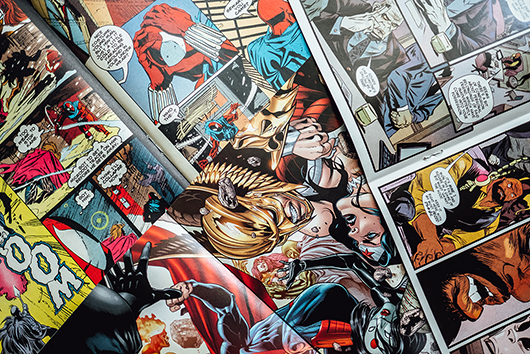How Many Pages Do You Need to Print a Comic Book?
November 26, 2020
The process of creating and printing a comic book or graphic novel is arduous and rewarding. A lot goes into this creation process – time, imaginative output, and expertise.
Knowing about your chosen genre helps speed things along when creating a graphic novel from scratch. There’s no set way to create a comic. Many writers script it all in text, whereas others use sketches, panels, and speech bubbles from the outset.
You’ll need to know specific comic categories like binding styles, paper quality, weight, and page count. The more you know, the more professionally cohesive your comic book will be. An essential part of the comic book creation process is page count.
With the help of a professional printing service like Comix Well Spring, you will be knowledgeable and confident, and you’ll be sure of the important details like how many pages you need to print a comic book.
Page Count
Most comic books have a page count that is a multiple of 4. This is for a particular reason.
With most bindings, the printer prints out a page called a parent sheet, which can have either 8, 16, or 32 pages on one of the sheets of paper, depending on the size of your book, and cuts and staples them to create a book.
For this reason, your page count must be divisible by 4. For spiral- or wire-bound projects, you won’t need your page count to be a multiple of 4. Board books are also published differently and only require 2-page spreads.
Binding Styles
There are different ways to put books together. The way a comic book is bound depends on its length and the kind of paper you want to use.
Your paper weight will determine the binding and the overall weight and feel of the book. You can get your books bound with staples or perfect bound.
Staple-bound or Saddle Stitched Binding
The most inexpensive option is to get your comic staple-bound or saddle-stitched, when long printed sheets, including the cover, are stapled through the middle and folded to create a book.
The saddle-stitched book doesn’t last quite as long as the perfect-bound book, but it is a more ecologically prudent choice as it doesn’t waste book-binding glue.
Getting your comic saddle-stitched is an excellent and popular option, and it is easy to transport and slide onto the shelf of a comic shop. Another added benefit is that these classic comics lie flat, unlike perfect-bound books. This lets you open and leaf through the comic on a flat surface.
It also makes it easier to display crossover images or spreads. Sometimes, with perfect-bound books, parts of a spread will be lost in the deep crease at the spine.
Perfect-bound Binding
This type of binding creates a flat surface on which to display the book’s name, the author, and sometimes the volume number. They are substantially more expensive, have great longevity, and look professional and sleek.
Perfect-bound comic books are bound with book-binding glue holding the pages to a strong, flexible spine. Graphic novels are often longer than regular comic books, and so the perfect-bound technique is often used for these more extended works.
Interior Page Count
In the printing industry, there are interior page minimums and maximums. This will help you, especially if you are anxious that your book is too short or too long. With different paper weights, you can usually find a solution, increasing and decreasing your page count as needed.
A saddle-stitched book cannot accommodate too large a page count because the staples won’t hold. Usually, saddle-stitching only goes up to 92 pages. Conversely, perfect bound books have a minimum word count because they need to have a certain number of pages to make a spine.
There are always a few pages dedicated to acknowledgments and the like, and you have to factor the cover and these additional pages into the total. An expert printing service can help you figure out the perfect paper weight and page count for your project.
Most of the time, comics top out at 8, 16, or 32 pages, although most offset printing services require 8 pages minimum and a maximum of 92. For an 8-page comic, you should include 5 or 6 pages of work; for a 32-page comic, a popular page count, you should have about 28 to 30 internal pages, and so on.

The Final Word
There’s a lot of ins and out to the printing industry, which has been going strong since the Gutenberg Printing Press’s invention in the 15th century. The more you know about the process, the better choices you can make when you begin your creative journey.
In the process, from a great idea to an actual comic book you can hold in your hands, you need professional guidance. Comix Well Spring, an expert printing service, knows everything you need to get the little details, like page count, right the first time.

